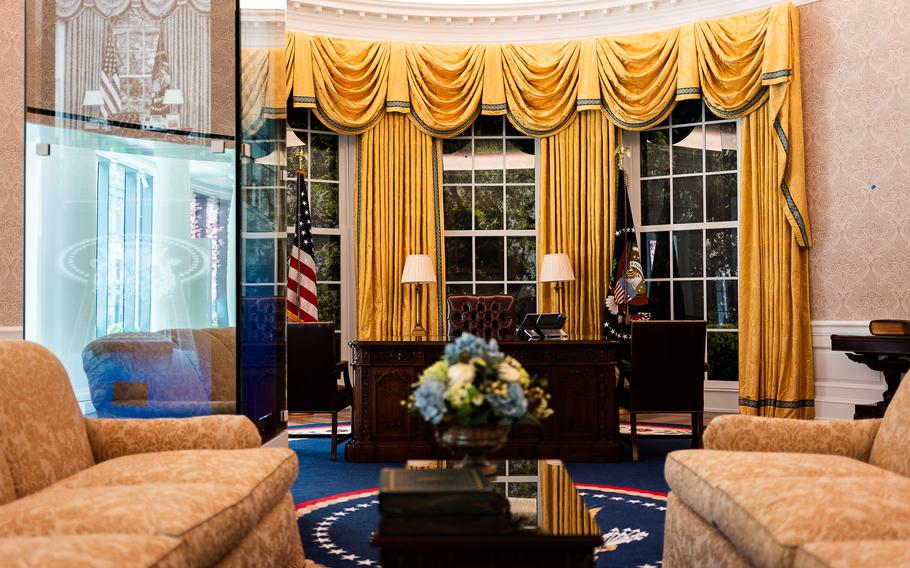
The public can visit a full-scale replica of the Oval Office, furnished with reproductions of the art, objects and furniture that adorn the president’s office, at the People’s House: A White House Experience. (Tierney L. Cross/For The Washington Post)
Who’ll be sitting in the Oval Office next year? It could be you.
Okay, not THAT Oval Office. We’re talking about a life-size replica where people can take selfies at the president’s Resolute Desk, one of the interactive attractions at a new museum created by the White House Historical Association.
Visitors from around the world want to see 1600 Pennsylvania Ave., but most can only stand outside the gates and take a photo. Now they can go just one block down the street to the People’s House: A White House Experience and learn about the legacy, customs and inhabitants of the nation’s executive mansion. The exhibit, which opened Monday, is free to the public.
The privately funded, $85 million, 33,000-square-foot project mixes history with high tech to give visitors a glimpse into parts of the White House they wouldn’t even see on an official tour, such as the Oval Office and Cabinet Room.
“The White House itself is an accredited museum,” says Stewart D. McLaurin, president of the White House Historical Association. “We honor that, we support that and we’re deeply involved in that. We don’t want to create another Washington museum experience with objects under glass and framed things on the wall. You come into the doors of the People’s House and you are immediately immersed into technology, digital content that brings the White House to life around you.”
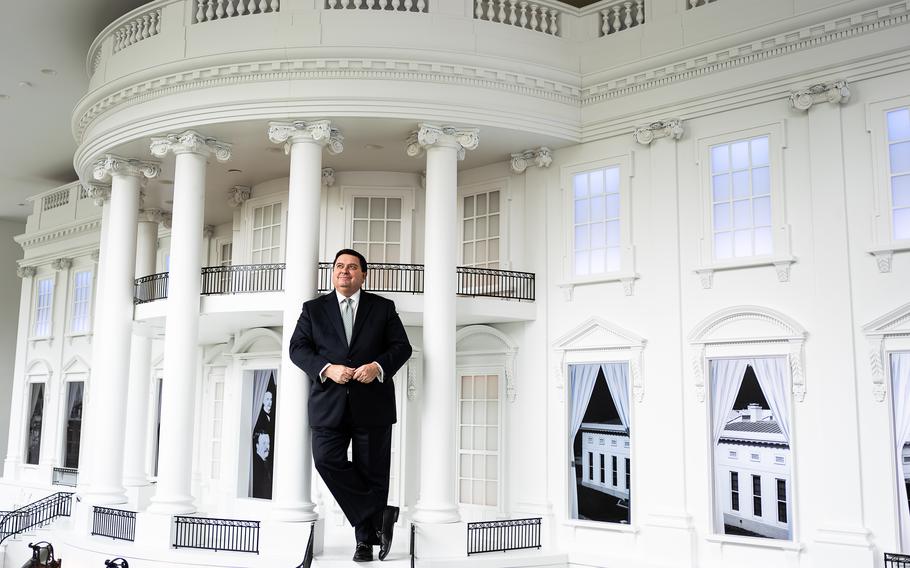
Stewart D. McLaurin, president of the White House Historical Association, in front of a model of the White House at the new museum. The WHHA created the museum. (Tierney L. Cross/For The Washington Post)
If a video game and a history museum had a baby, it would be the People’s House. There’s a huge scale model of the White House with the public state rooms, the private quarters and all the furnishings. An open space transforms into the East, Red, Green, Blue and State dining rooms via state-of-the-art projections. Visitors will get the chance to attend a Cabinet meeting and a state dinner that come alive through audio and video elements. They can scroll through a gallery featuring interviews with the people — military aides, ushers, cooks, florists, gardeners and more — who serve in the executive mansion.
The idea is to provide a modern, more personal way to experience the executive mansion. It is designed to appeal not only to all the tourists and school groups who come to the nation’s capital each year (a record 26 million in 2023), but also to locals who love history and want to share it with their family and friends.
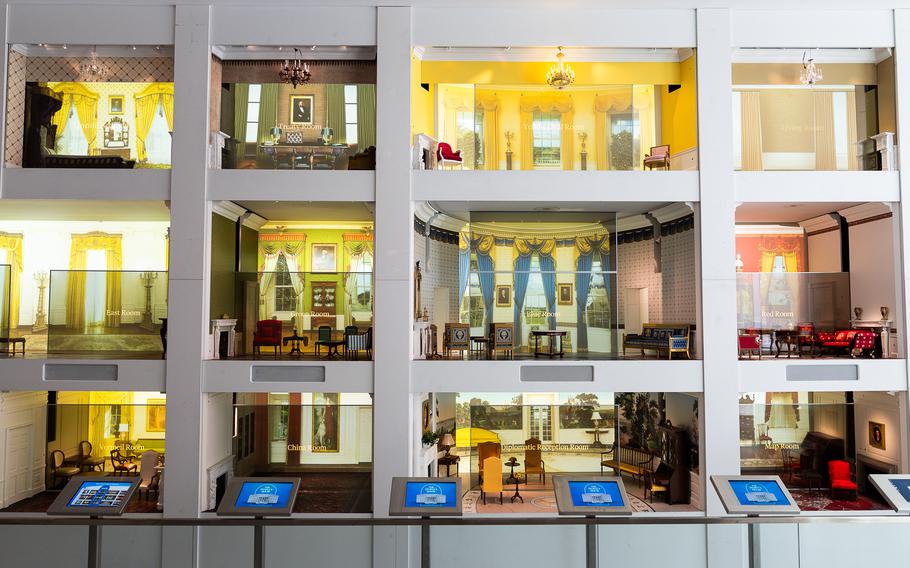
A multimedia look inside the White House at the People’s House: A White House Experience. (Tierney L. Cross/For The Washington Post)
In a town full of stately museums and galleries, the People’s House may be the most high-tech to date: a model of cutting-edge museum design. The big surprise is that it comes from the White House Historical Association, a low-profile, old-fashioned organization best known for books and Christmas ornaments.
A little history: The nonpartisan WHHA was created at the behest of Jackie Kennedy, who was dismayed by the state of the executive mansion when she moved in. Until 1961, the White House was (if we’re going to be honest) kind of run-down. It served as both a residence and an office, and each president and first lady could decorate the house as they pleased, often selling off outdated furniture and art.
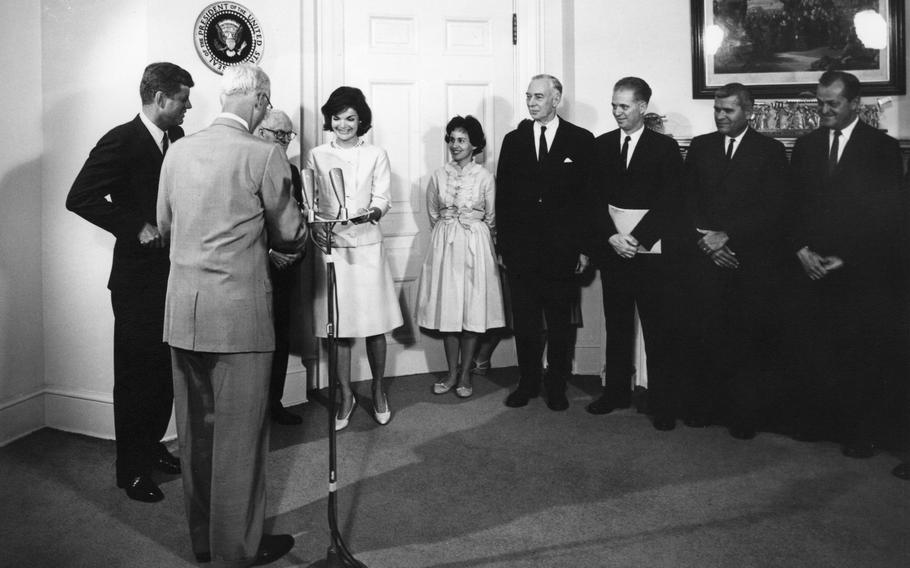
First lady Jackie Kennedy was instrumental in creating the White House Historical Association, which published guidebooks about the executive mansion. The WHHA created the new museum. (Tierney L. Cross/For The Washington Post)
Kennedy was determined to preserve and protect the White House as a living museum; the WHHA was founded as a nonprofit to help realize her dream. In 1962, it published the first edition of “The White House: An Historic Guide.” For six decades, the organization quietly raised $100 million to refurbish the public rooms of the White House, conserve the art collection and buy more than 600 historical objects for the permanent collection.
“We’ve always been very involved and focused on our primary mission, which is working collaboratively with each presidency,” McLaurin says. “Our role is exactly the same regardless of who the president and first lady may be. And half of that mission is to help maintain the museum standard of the White House interiors by acquisitions, conservation and preservation,” using private donations instead of taxpayer funding.
Consider, for example, the furniture in the Blue Room: James Monroe ordered a 53-piece set of gilded furniture from a French cabinetmaker when the White House reopened in 1817 after the British burned it down. By the time Abraham and Mary Lincoln moved in, only one of those 53 pieces was still there; the rest were sold or destroyed. The WHHA tried to find as many of those lost pieces as possible, but today only 13 of the originals are back in the White House collection.
But the other part of the mission was education: Kennedy asked the organization to create the guidebook, which was sold to visitors at the White House. The WHHA published more books, created White House-themed Christmas ornaments in 1981 and launched online and lecture programs. First ladies would help raise money here and there, but the main source of fundraising for three decades was income from ornament sales.
The pandemic gave the organization an unusual opportunity to expand as demand for its publications and online content soared.
“This history is so strong, and we wanted to have more of a visible, more of an accessible, more of a proactive outreach to do that,” McLaurin says.
So the WHHA went where it had never gone before: big, bold, expensive. An office building one block from the White House stood empty and the owners agreed to a 25-year lease for the first three floors. A campaign to raise $85 million — $35 million for creating the exhibits and a $50 million endowment to keep it constantly updated — was launched in the spring of 2023 with the goal of opening 18 months later. It wasn’t a hard sell, especially for first-generation Americans. Individual donors include philanthropists David Rubenstein, Jackie Mars, Tatiana Copeland, Amelia Ogunlesi, Ghada Irani and Ashley Dabbiere; Apple and Lockheed Martin lead the list of corporate contributors.
The board tapped Luke Boorady, a former staffer working at a museum exhibit design firm, as project manager. The mandate: Create a crowd-pleasing space that could appeal to kids and their grandparents alike using the most accessible equipment — touch screens, transparent monitors — to bring the White House to life. Panasonic donated a large amount of the technology; the exhibit was designed by Ralph Appelbaum Associates, which also did much of the Smithsonian’s acclaimed National Museum of African American History and Culture.
“For us, it was, ‘Let’s use trusted technology and put some purpose and historical importance behind it,’” Boorady says. “We think when White House history is relatable, it’s most impactful.”
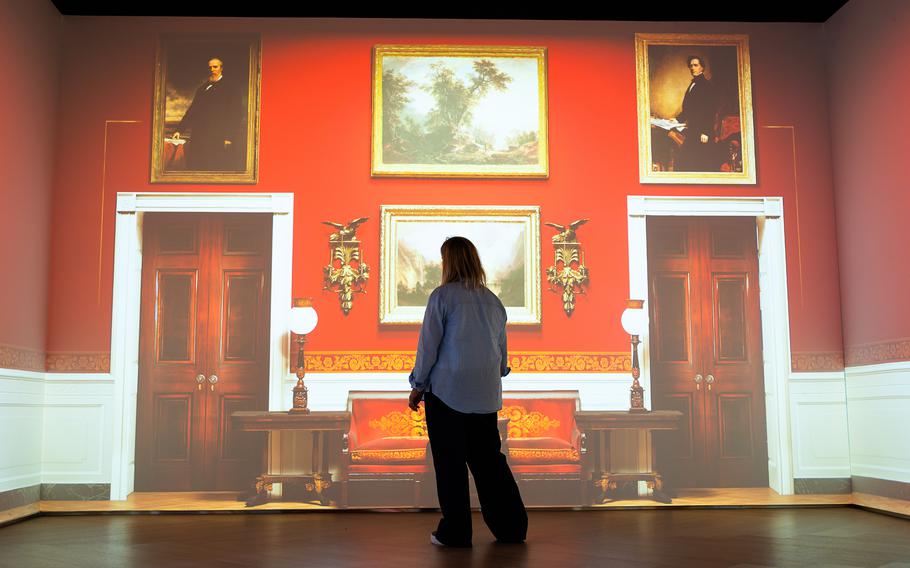
A digital projection of the Red Room, where visitors can touch objects on the walls to learn more about them. (Tierney L. Cross/For The Washington Post)
Instead of text or audio guides, the exhibit relies on interactive screens, rotating projections and displays. The tour starts with an oversize model of the White House, which includes a digital overlay of the 1814 fire that gutted it. The neighboring space uses projections to transform bare walls into the house’s public rooms, such as the East Room with the Gilbert Stuart portraits of George and Martha Washington. A touch pulls up more information on each element in each room. Tap the window in the Green Room, for instance, and you’ll see Marine One landing on the South Lawn.
Next door, the Oval Office, an almost-exact model built to the measurements of the original, looks like a movie set and a backdrop for One-Day-I’ll-Be-President selfies.
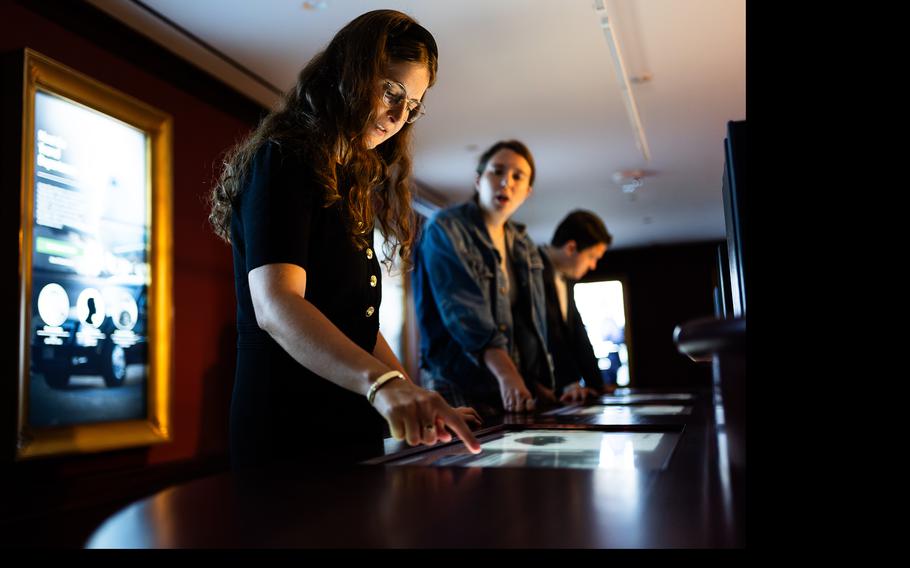
People interact with a responsive research table that explores the role and contributions of officials at the White House. (Tierney L. Cross/For The Washington Post)
The second floor is a dive behind the scenes: an interactive gallery of the people who live and work in the White House, most of whom serve for decades without any public recognition. There are facts about every president and first lady, but also interviews with ushers, cooks and other staffers. Around the corner, visitors can sit in the Cabinet Room and listen to Abraham Lincoln and his Cabinet debate entering the Civil War, Franklin D. Roosevelt tackle the Great Depression in his first days in office and John F. Kennedy confront the threat of the Cuban missile crisis — conversations all re-created from historical records. The self-guided tour includes a state dinner and a re-creation of the White House family theater with footage of the first families (and first pets), plus pop quizzes on presidential trivia.
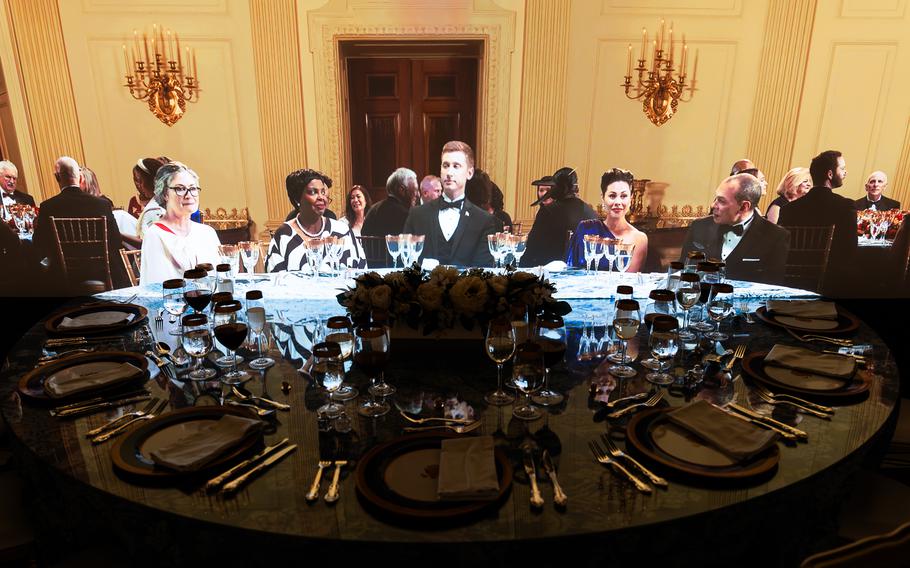
Visitors will find out what it’s like to be a guest at a state dinner at the People’s House: A White House Experience. (Tierney L. Cross/For The Washington Post)
The final room, “Stories in Objects,” is a collection of seemingly random stuff that comes alive when activated. A replica of a giant piece of cheese? That’s the 1,400-pound block Andrew Jackson served to the public in 1837. (It was devoured in two hours.) The room also features a view of Pennsylvania Avenue and the Old Executive Office Building.
On the third floor, project designers added classrooms for student and community tours and a lecture space. The tour ends with a giant gift shop because — well, did you even visit if you didn’t buy a souvenir?
“A lot of us are just White House nerds, right?” Boorady says. “But we think there’s always been this underlying desire to educate people as much as we can about the White House. Our daily Facebook posts and social media posts and even the ornament, we see those as educational tools. This is just taking that next step.”
Behind the razzle-dazzle and the presidential trivia lies the hope that something important, something deeper will come from this exhibit: a better understanding of what the White House represents in this country and around the world.
For Desiree Watson, a donor and member of the WHHA’s National Council, the People’s House presented a unique opportunity to engage the next generation, especially those who have fewer resources and opportunities. She was part of the team that brainstormed what should be included and why.
“I spoke about how we need to meet young people where they are, and we need to definitely elevate the experience of the White House,” Watson says. “How can we make this an experience for everyone to enjoy?”
Kids, she says, need to understand what the White House represents for them, what democracy represents, what the presidency —not an individual but an office — means for them as Americans. The idea of citizens sharing mutual goals, mutual respect, a mutual assumption of patriotism and community can be rooted in a greater understanding of history, the good and the bad.
Watson is a big fan of Jacqueline Kennedy, who was just 31 when she moved into the White House. She sees the mission of the People’s House as elevating Kennedy’s vision for the next generation.
McLaurin, the WHHA president, also has the next generation in mind as the museum opens.
“The thing I love most about our mission is education,” he says. “You never know the seed you plant.”
Behind his desk is an old black-and-white photo of his fifth grade class trip to Washington: He’s sitting on the lawn of the Capitol; he has vivid memories of touring the White House and Mount Vernon, too.
“I remember those places coming alive for me, and I was able to understand and visualize them in a different way having been here,” he says.
He can’t say what impact that had on his current career, in which he spends all his time thinking about American history, but he still remembers that trip fondly. Now he’s hoping the same thing happens to a young student coming to Washington and visiting the People’s House.
Maybe one will be a future president of the United States?
“Maybe,” he says. “And the great thing is, I’ll never know that. But maybe.”
If you go: The People’s House
1700 Pennsylvania Ave. NW. thepeopleshouse.org
Hours: Daily from 9 a.m. to 5 p.m. (Closed Thanksgiving, Christmas and New Year’s Day.)
Tickets: Free, timed-entry passes can be reserved at thepeopleshouse.org. A small number of walk-up passes will be available on a first-come, first-served basis. (The WHHA suggests a $15 donation to support educational programs, but it is not mandatory.) The gift shop does not require a pass.
Timing: Organizers estimate it will take about 75 to 90 minutes to go through the entire exhibit, although it can take longer if visitors explore every interactive option.